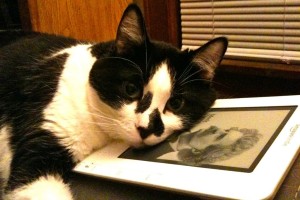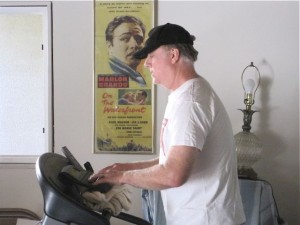About this time last year, TKZ hosted a couple of spirited discussions about the merits of e-books, Kindles, and electronic publishing in general. After watching my 82-year-old mother become a devoted “Kindle convert” during the course of a recent cross-country road trip, I suspect that the technology battle is over. E-books have won.
My mother (nicknamed “Mimi” by friends and family) and I recently drove from South Carolina to Los Angeles in a cream puff of a car, a ’99 Mercedes sedan (it had only 17,000 miles on it when we hit the road). My sister had given Mimi a Kindle at the outset of our trip–and as we set off, my mother was a gracious but reluctant recipient. Thanks, she said, but I’ll never be able to hold it right for reading. It just won’t feel the same as a book. Will I have to keep it on a wire like the laptop I never use?
And then she plugged it in. Two days later, I couldn’t pull her away from the thing.
By the time we got to Phoenix, Mimi had already made her way through two Stieg Larsson books, and was downloading more. She was so enraptured by the reading experience that she was barely coming up for air.
Before she got her Kindle, Mimi was a voracious reader, but her buying habits wouldn’t have brought joy to publishers. Unable to make it out to the library anymore, she had become an avid reader of used books–we would send her box loads of second hand books. As a child of the Depression, Mimi thinks paying $26.95 for a brand new hardback is practically sinful, and she’d fuss at us if we splurged on any title we could have bought used from Amazon at a fraction of the price.(I tried to explain to her that buying new books helped ensure the future of her favorite authors, but try explaining that to someone who peeled the foil off the backs of gum sticks during World War II).
Mimi is so excited about her Kindle, it’s like we’ve given an addict her first hit. She rhapsodizes about how you can increase the font size, and the long battery life.
After all the angst and anguish about what e-books will do to publishing, I think the future is bright–in the future, readers like Mimi will be downloading and paying full price for e-books. By being able to browse and read samples online, they’ll be exposed to new releases and other books they may never otherwise have read. And–did I mention? They’ll pay full price.
I think this is great news for writers and publishers. I call it the “82-year-old mother test.” Bottom line: If Mimi loves your product, you’ve got a great future. And boy, does Mimi love her new Kindle.
If my mother has joined the ranks of e-reader converts, I’m ready to declare an end to the debate (at least on Tuesdays, which is my blog day). The e-book era is officially here. May we all live long, e-read, and prosper.
What about you? Have you overcome previous doubts about e-books and joined the ranks of e-readers? Are you secretly hoping for an iPad, Nook, or Kindle this year?









